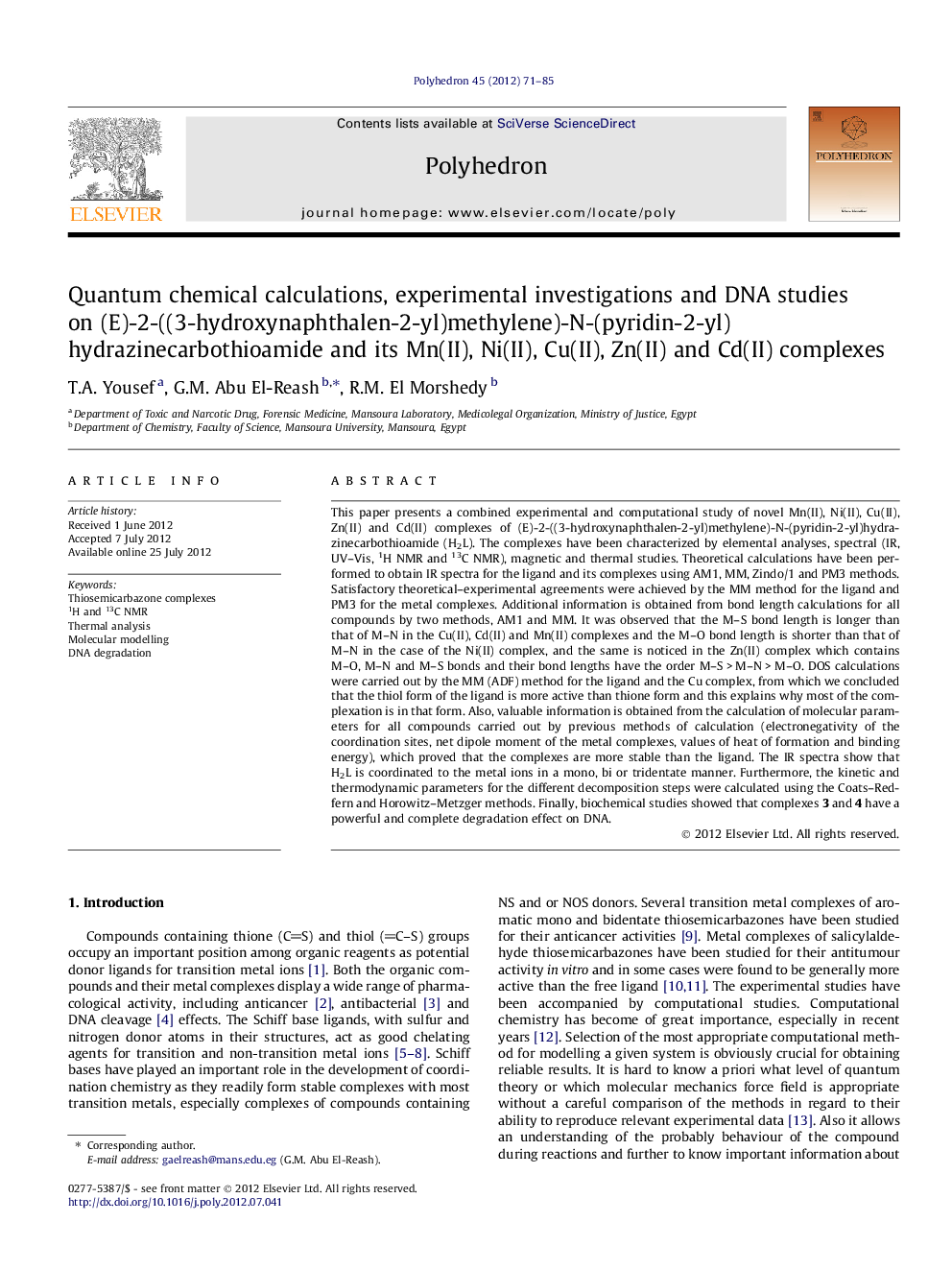| کد مقاله | کد نشریه | سال انتشار | مقاله انگلیسی | نسخه تمام متن |
|---|---|---|---|---|
| 1337287 | 979625 | 2012 | 15 صفحه PDF | دانلود رایگان |

This paper presents a combined experimental and computational study of novel Mn(II), Ni(II), Cu(II), Zn(II) and Cd(II) complexes of (E)-2-((3-hydroxynaphthalen-2-yl)methylene)-N-(pyridin-2-yl)hydrazinecarbothioamide (H2L). The complexes have been characterized by elemental analyses, spectral (IR, UV–Vis, 1H NMR and 13C NMR), magnetic and thermal studies. Theoretical calculations have been performed to obtain IR spectra for the ligand and its complexes using AM1, MM, Zindo/1 and PM3 methods. Satisfactory theoretical–experimental agreements were achieved by the MM method for the ligand and PM3 for the metal complexes. Additional information is obtained from bond length calculations for all compounds by two methods, AM1 and MM. It was observed that the M–S bond length is longer than that of M–N in the Cu(II), Cd(II) and Mn(II) complexes and the M–O bond length is shorter than that of M–N in the case of the Ni(II) complex, and the same is noticed in the Zn(II) complex which contains M–O, M–N and M–S bonds and their bond lengths have the order M–S > M–N > M–O. DOS calculations were carried out by the MM (ADF) method for the ligand and the Cu complex, from which we concluded that the thiol form of the ligand is more active than thione form and this explains why most of the complexation is in that form. Also, valuable information is obtained from the calculation of molecular parameters for all compounds carried out by previous methods of calculation (electronegativity of the coordination sites, net dipole moment of the metal complexes, values of heat of formation and binding energy), which proved that the complexes are more stable than the ligand. The IR spectra show that H2L is coordinated to the metal ions in a mono, bi or tridentate manner. Furthermore, the kinetic and thermodynamic parameters for the different decomposition steps were calculated using the Coats–Redfern and Horowitz–Metzger methods. Finally, biochemical studies showed that complexes 3 and 4 have a powerful and complete degradation effect on DNA.
The paper presents a combined experimental and computational study of novel Mn(II), Ni(II), Cu(II), Zn(II) and Cd(II) complexes of (E)-2-((3-hydroxynaphthalen-2-yl)methylene)-N-(pyridin-2-yl)hydrazinecarbothioamide (H2L). The complexes have been characterized by elemental analyses, spectral (IR, UV–vis, 1H NMR and 13C NMR), magnetic and thermal studies. Theoretical calculations have been performed to obtain IR spectra for ligand and its complexes using AM1, MM, Zindo/1, PM3 methods. Satisfactory theoretical-experimental agreements were achieved by MM method for ligand and PM3 for the metal complexes. Furthermore, the kinetic and thermodynamic parameters for the different decomposition steps were calculated using the Coats-Redfern and Horowitz-Metzger methods. Finally, the biochemical studies showed that, complex 3, 4 have powerful and complete degradation effect on DNA.Figure optionsDownload as PowerPoint slide
Journal: Polyhedron - Volume 45, Issue 1, 19 September 2012, Pages 71–85